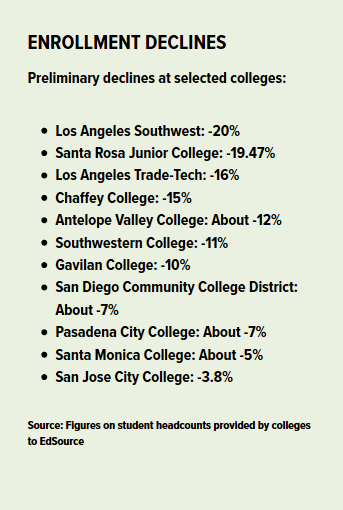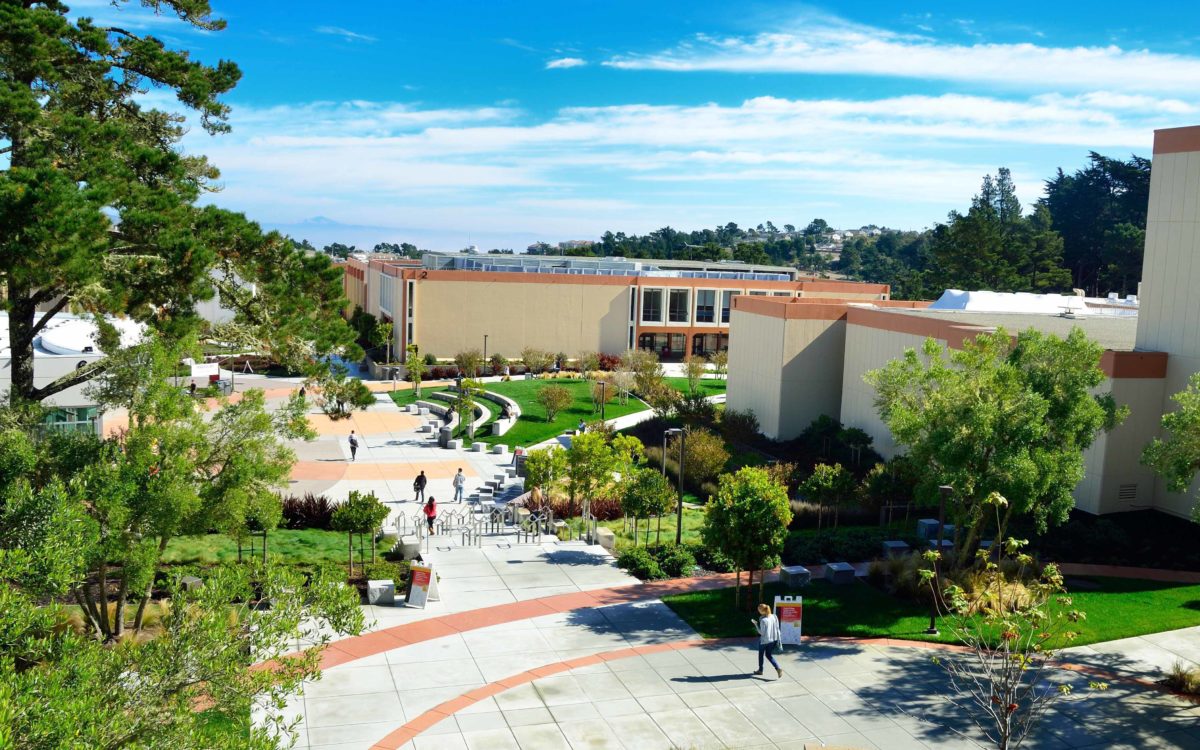IN THE NEWS: Fewer students attending California community colleges, early fall numbers show
By Ashley A. Smith
Via EdSource: https://edsource.org/2020/fewer-students-attending-california-community-colleges-early-fall-numbers-show/640373
California’s community college system is experiencing a system-wide decline of student enrollment this fall, with some campuses reporting double-digit losses.
The fact that fewer students have enrolled for this fall reveals a worrisome decline for the nation’s largest college system — with 116 institutions serving more than two million students. While enrollments have been largely flat in recent years, with variations among the colleges, the situation appears to be different this year, with the picture complicated by the coronavirus pandemic, job losses, the transition to mostly online classes and historic wildfires.
“This is an issue that we’re paying very close attention to, that we’re very concerned about, particularly as it relates to any loss of enrollment for our most vulnerable student populations,” California Community Colleges Chancellor Eloy Ortiz Oakley said during a Board of Governors meeting Monday. “We did begin the (fall) semester with a brief decline in enrollment. We’re beginning to see that gap close. We’ll have more data come November but right now we’re probably looking at around a 5% to 7% decrease in enrollment so far.”
Oakley said the college system also saw “an enrollment increase during the summer session, which is good news. Many students were able to recover from the onset of the pandemic and take classes that they needed.”
Oakley’s numbers are based on a community college survey to which less than half of the colleges have responded so far, with most reporting declining enrollments, counting both part-time and full-time students. Some colleges are bucking the trend, and reported slightly higher enrollments, officials said.
Nationally, community colleges are seeing what appear to be even more significant enrollment declines than California. The 24-campus Alabama Community College system, for example, has seen a 29% decline, and enrollments at the 14 community colleges in Pennsylvania are down anywhere from 3% to 30% this fall, according to Inside Higher Ed.
Typically, in an economic recession enrollments in community colleges increase because students have a harder time finding jobs, and seek to improve their skills by taking college classes.
In the past, community colleges have experienced slight declines in enrollment when the economy is doing well and students have chosen to work instead of going to school.
But the declining enrollments during the current recession are at least in part a reflection of students’ reluctance or inability to participate in online instruction, said Michelle Siqueiros, president of the Campaign for College Opportunity, a California-based advocacy organization. “While many of us are tech-savvy, there’s really a sense that students want to be in the classroom,” she said. “This could be a lost generation because typically students who drop out or don’t enroll in college don’t go back.”
Information provided to EdSource from selected colleges indicate a wide range of enrollment declines, from 3.8% to 20%.

One of the colleges hardest-hit by an enrollment decrease this fall is Santa Rosa Junior College, where student headcount for this fall is down 19.47% from 24,062 last year.
“When the pandemic hit, we had to shut down a lot of our career education courses like automotive, welding and our restaurant program in culinary arts,” Santa Rosa President Frank Chong said. “We’re back up with culinary arts, but a lot of students don’t like to learn remotely and some are dealing with personal hardship.”
Chong attributes some of the decrease in students to the wildfires and poor air quality, forcing people to evacuate their homes in Sonoma County.
César Ramirez, a computer science major at Los Angeles City College, has decided not to return to school this fall. He said right now he doesn’t see a reason to return when he could be working and supporting his family. “Living in this current situation, I found it more important to use all the money that I have saved up for school as personal savings for my family and me because there is no clear date as to when things are going back to normal,” said Ramirez, who lives with his mother and 11-year-old sister. “I’m just prioritizing having something saved up rather than using it all for school.”
Within the nine-college Los Angeles Community College District, two of its colleges saw double-digit decreases in enrollment. Los Angeles Southwest College, with just over 14,000 students last year, and Los Angeles Trade-Technical College, with 7,396 students, are down 20% and 16% respectively this fall. District-wide, the colleges have maintained 90% of their enrollment, said Chancellor Francisco Rodriguez. Last year, the district enrolled about 145,000 students.
“We’re seeing that Covid is having a disproportionate impact on students who are poorer,” Rodriguez said. “The two colleges that serve the poorest or lowest-income students have the greatest drops in enrollment.”
L.A. Trade-Tech and L.A. Southwest college students tend to have less access to healthcare, less reliable Internet connectivity and fewer resources, in general, he said. The district estimates about 30,000 students in the Los Angeles area don’t have access to computers, technology or reliable Internet. To help students cope with online learning, the district has distributed about 16,000 Chromebooks and another 15,000 are “on the way,” Rodriguez said.
Sofia Urbina, a library technician major at L.A. City College, said she is considering dropping out this fall after spending five years at the college as a part-time student. The 22-year-old lives with her parents, sharing a one-and-a-half bedroom home with eight other relatives, including her parents, four cousins between the ages of 7 and 11, and a 4-year-old niece.
Even before the pandemic, all of Urbina’s classes were virtual. But she says her crowded living situation now leaves her with little space to work. “When the pandemic hit we were all basically here at the same time,” she said. Interruptions are common. Sometimes when she is trying to do school work, she said, one of her family members might say “Oh, can you do the dishes?”
When El Camino College in Torrance transitioned to mostly online learning this fall, Kaila Cash, a 20-year-old business and cosmetology major, decided not to show up for class. “I’m the type of student that has to be physically there in order to understand what I’m being taught,” she said.
Cash says postponing community college is frustrating because she already stopped once before. She was enrolled at Cal State Dominguez Hills to study communications. But when her grandmother died the summer before her sophomore year, she dropped out as her grades declined. She later enrolled at El Camino College and changed her major to something she’s more passionate about: cosmetology.
“I’m not really all that good with school,” Cash said, “That’s why my two years at Dominguez Hills were hard. When I started going to El Camino, I actually was getting better grades. I was like a 3.0 average.”
However, she says she finds the notion of studying online for her cosmetology degree strange. “It’s hard doing cosmetology online,” she said. “It’s more of a hands-on thing. You can see what you’re being taught.” So, instead of going to school, she plans to continue working part-time at Whole Foods where she makes $15 an hour. The money, she says, will help her save up for college in the future.
There are other reasons enrollments have declined at some community colleges. Chaffey College, in Rancho Cucamonga in San Bernardino County, shifted the start of about 200 classes from August to September and October, resulting in a 15% decline in fall student enrollment. In Fall 2019, the college had 22,776 students.
“We did this to give students more time to decide on the next steps of their academic journey, since Covid-19 has dramatically affected their lives,” said Melissa Pinion, a college spokesperson. “We expect our enrollment numbers to increase as the semester continues and students enroll in those additional sections.”
And at Southwestern College in Chula Vista hear the Mexico border, most of that college’s 11% enrollment decline can be attributed to decreases in performing arts, and wellness and exercise science classes that had to go online. Those classes are experiencing a 25% enrollment decline, said Lillian Leopold, a spokesperson for the college, which served about 20,648 students last year.
Despite the decrease, many community colleges expect enrollment to recover, if just a little, once they can count the full student-body this fall. At Santa Rosa, President Chong said he expects the decrease to be less than 20% once the college counts its “late-start” classes, or those that begin after Oct.1, along with non-credit students.
In the Los Angeles district, officials also expect an enrollment increase from students in late-start classes, dual enrollment courses attended by high school students, and adult education courses, Chancellor Rodriguez said.
San Jose City College is currently down about 3.8% from 9,122 students last year, the college noticed a surge in enrollment in the last few days before the start of the semester on Aug. 31. “We believe it was the result of efforts by our outreach team and marketing initiatives,” said Daniel Rivera Garza, communications director for the college. “We continue our marketing effort to promote and boost our late start courses, which we hope will result in additional enrollment by the end of term.”
And both community colleges in the Foothill De Anza Community College District in Santa Clara County, which is on the quarter system, started classes Monday. A spokesperson for the district its enrollment showed an increase as of this week.
As for Kaila Cash, she’s considering returning to El Camino College next year. “Even if it takes a while for me to get where I want to be with school, I’m perfectly okay with that,” she said.
Michael Burke, Daniel J. Willis and Louis Freedberg contributed to this report. Also contributing are members of EdSource’s California Student Journalism Corps: Hannah Getahun and Iman Palm from Cal State Long Beach, and Marlene Cordova from Cal State Los Angeles.
To get more reports like this one, click here to sign up for EdSource’s no-cost daily email on latest developments in education.

